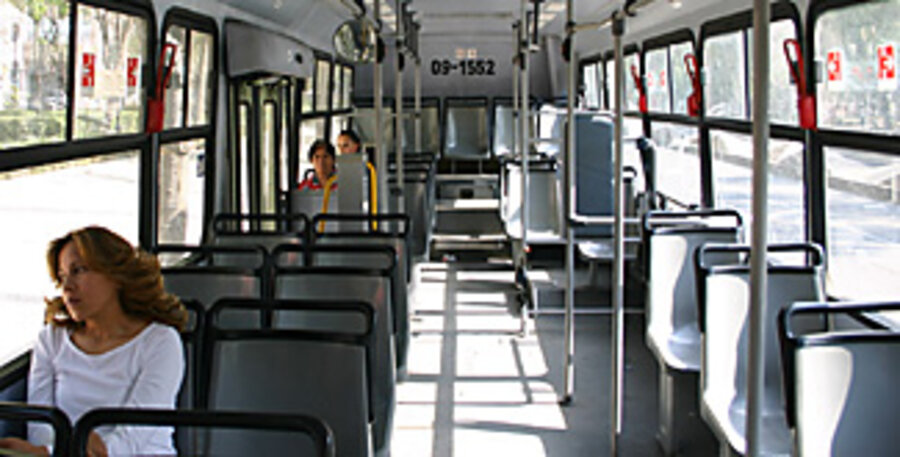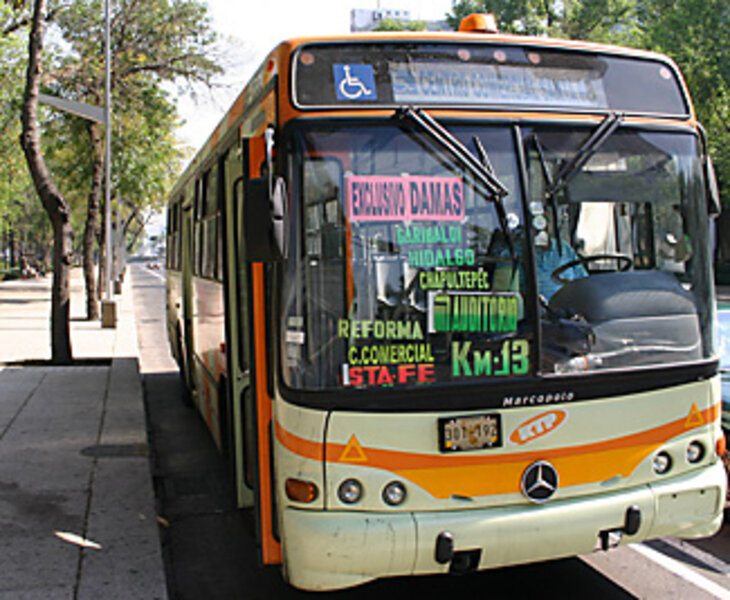Mexico City's newest bus option: 'Ladies Only'
Loading...
| Mexico City
It is nearing rush hour along one of Mexico City's main boulevards, and the passing city buses are a blur of mashed cheeks and miserable scowls.
And then rolling down the road comes what seems like an alien object at this time of day: A bus with breathing space, empty seats, even a few smiles. On the front window is a sign: "Exclusively for Ladies."
Welcome to Mexico City's latest effort to make its infamously inhospitable city more manageable. The city's new female-only bus service, which began this month, is a response to complaints by women over an unacceptable number of sexual passes, verbal abuse, and lewd looks on their daily commute.
"They touch you, and push up against you or jeer at you," says Soledad Barcenas, as she waits at a bus stop for the new service. She allows three regular buses to pass by – after picking her 10-year-old niece up from school. "I care most because of her; she loves it."
The program was launched along two bus routes, and the city hopes to expand it to 15 of its 88 routes in the upcoming months. So far, 20,000 women have hopped aboard, says Ariadna Montiel Reyes, the head of Mexico City's public bus system.
As a woman in the male-dominated transport agency, she says, she has a unique perspective on sexual harassment. "When I was studying architecture at my university, apart from the discomfort of carrying all of my [tools], it happened to me. There are few women who would say they have not experienced this on public transportation."
Separating men and women on rails and roadways in an effort to increase women's safety and sense of security has been implemented elsewhere. Mexico City has been shuttling women and children into separate subway cars during rushhour for years.
Mexico City's latest scheme comes as women are asserting a greater intolerance toward sexual misconduct on public transportation across the globe. Nations from Egypt to Brazil have experimented with similar initiatives. Two summers ago, in New York City, plainclothes police staged a sting targeting gropers. It stemmed in part from a blog called hollabacknyc.com, which recounts stories of harassment. Similar blogs have spread to other regions of the country, as well as Canada.
Some see a segregation of the sexes on public transportation as regressive. Roberto Martinez, a retired union worker in Mexico City, says he is not against the idea. But he says that the city is better off focusing on education so that women are not mistreated or objectified in the first place. "Society has lost its values," he says.
And he says that, while women are more vulnerable on crammed public transportation, men are not always the villains some paint them to be. "If we touch a woman on a packed bus, it's not always on purpose," he says.
Currently 12 buses, which look like regular ones except they are decorated with pink "women only" signs, run between 6 a.m. and 9 p.m. daily. Whether this initiative will keep women safer on their commutes is up for debate. Patricia Ramirez, a smartly dressed woman on her way home from a shopping mall in the center of the city, definitely says she is happier on the women-only service. "This is much nicer; I actually have a seat," says Ms. Ramirez, whose one-hour commute to work can be exhausting. "Usually the bus is full of men – all sitting."
But, Ramirez says, she isn't likely to arrange her schedule around a more comfortable bus. "I'll take whatever bus comes first. I have to get to work."
So far, the service has only galled a few men here and there. Ms. Barcenas says that one man refused to get off the bus she was riding. "He started yelling, 'If this is public transportation, why isn't it for all of the public?' " The bus driver had to physically remove him, she says.
Driver Eduardo Rivera Ayala gently tells those men who climb into his bus – apparently overlooking the pink signs plastered on its front and side – that they aren't allowed on.
On this day none puts up a protest. But others have – which makes his 25-year stint as a city bus driver a little more difficult these days, he says.
On the other hand, he says, it's a lot easier in other ways. "Women are calmer. And cleaner."






